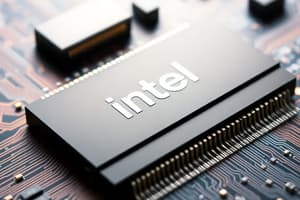Podcast
Questions and Answers
What is the width of the data bus in the Intel 8086 microprocessor?
What is the width of the data bus in the Intel 8086 microprocessor?
- 16-bit (correct)
- 32-bit
- 64-bit
- 8-bit
Which register in the Intel 8086 microprocessor points to the current instruction to be executed?
Which register in the Intel 8086 microprocessor points to the current instruction to be executed?
- IP (correct)
- SP
- BX
- AX
Which mode in the Intel 8086 microprocessor supports multiple processors?
Which mode in the Intel 8086 microprocessor supports multiple processors?
- Protected Mode
- Maximum Mode (correct)
- Minimum Mode
- Real Mode
How many registers does the Intel 8086 microprocessor have?
How many registers does the Intel 8086 microprocessor have?
Which type of instruction is not supported by the Intel 8086 instruction set?
Which type of instruction is not supported by the Intel 8086 instruction set?
Flashcards are hidden until you start studying
Study Notes
Overview
- The Intel 8086 is a 16-bit microprocessor designed by Intel and introduced in 1978.
- It is the first member of the x86 architecture family.
Architecture
- Data Bus: 16-bit, allowing transfer of 16 bits of data at a time.
- Address Bus: 20-bit, capable of addressing up to 1 MB of memory.
- Registers: Contains 14 registers, including:
- General purpose registers: AX, BX, CX, DX.
- Segment registers: CS (Code Segment), DS (Data Segment), SS (Stack Segment), ES (Extra Segment).
- Pointer registers: IP (Instruction Pointer), SP (Stack Pointer), BP (Base Pointer).
Instruction Set
- Supports over 100 instructions, categorized into:
- Data transfer (MOV, PUSH, POP)
- Arithmetic (ADD, SUB, MUL, DIV)
- Logic (AND, OR, XOR, NOT)
- Control transfer (JMP, CALL, RET)
Segmentation
- Memory is divided into segments for organization:
- Code segment: Contains executable code.
- Data segment: Holds variables and data.
- Stack segment: Supports function calls and local variables.
Operating Modes
- Minimum Mode: Single processor mode, control signals generated by the processor.
- Maximum Mode: Supports multiple processors, requires external bus controller.
Performance
- Capable of executing up to 600,000 instructions per second.
- Uses a 6 MHz clock speed in its initial design.
Applications
- Early personal computers and embedded systems.
- Foundation for later x86 processors.
Compatibility
- Backward compatible with older Intel processors, allowing for easier software migration.
Key Features
- Supports up to 1 MB of RAM.
- Can be combined with co-processors for enhanced arithmetic operations (e.g., Intel 8087).
Development Tools
- Assembler and debugger tools available for programming and testing applications.
Conclusion
- The 8086 microprocessor laid the groundwork for modern computing architecture, influencing processor design and software development for decades.
Overview
- Intel 8086, a 16-bit microprocessor, was introduced in 1978.
- It is the pioneer of the x86 architecture family, which has influenced future processors.
Architecture
- Data Bus: 16-bit width allows simultaneous transfer of 16 bits of data.
- Address Bus: 20-bit length enables addressing of up to 1 MB of memory space.
- Registers: Comprises 14 registers:
- General Purpose: AX, BX, CX, DX for various operations.
- Segment Registers: CS (Code Segment), DS (Data Segment), SS (Stack Segment), ES (Extra Segment) for memory management.
- Pointer Registers: IP (Instruction Pointer), SP (Stack Pointer), BP (Base Pointer) for execution control.
Instruction Set
- Features over 100 instructions categorized into:
- Data Transfer: Instructions like MOV, PUSH, POP for moving data.
- Arithmetic Operations: ADD, SUB, MUL, DIV for calculations.
- Logic Operations: AND, OR, XOR, NOT for bit manipulation.
- Control Transfer: JMP, CALL, RET for altering execution flow.
Segmentation
- Memory is organized into segments:
- Code Segment: Stores executable code.
- Data Segment: Contains variables and program data.
- Stack Segment: Manages function calls and local variables.
Operating Modes
- Minimum Mode: Operates as a single processor with internal control signals.
- Maximum Mode: Supports multiple processors and requires an external bus controller.
Performance
- Executes up to 600,000 instructions per second.
- Initially designed with a clock speed of 6 MHz.
Applications
- Used in early personal computers and embedded systems.
- Establishes a foundation for subsequent x86 processors.
Compatibility
- Backward compatible with older Intel processors, facilitating software migration and legacy support.
Key Features
- Supports up to 1 MB of RAM, enabling program execution and data storage.
- Can be paired with co-processors, such as the Intel 8087, to enhance arithmetic capabilities.
Development Tools
- Programmers have access to assembler and debugger tools for application development and testing.
Conclusion
- The Intel 8086 microprocessor established fundamental principles of modern computing architecture, exerting a lasting influence on processor design and software development.
Studying That Suits You
Use AI to generate personalized quizzes and flashcards to suit your learning preferences.




